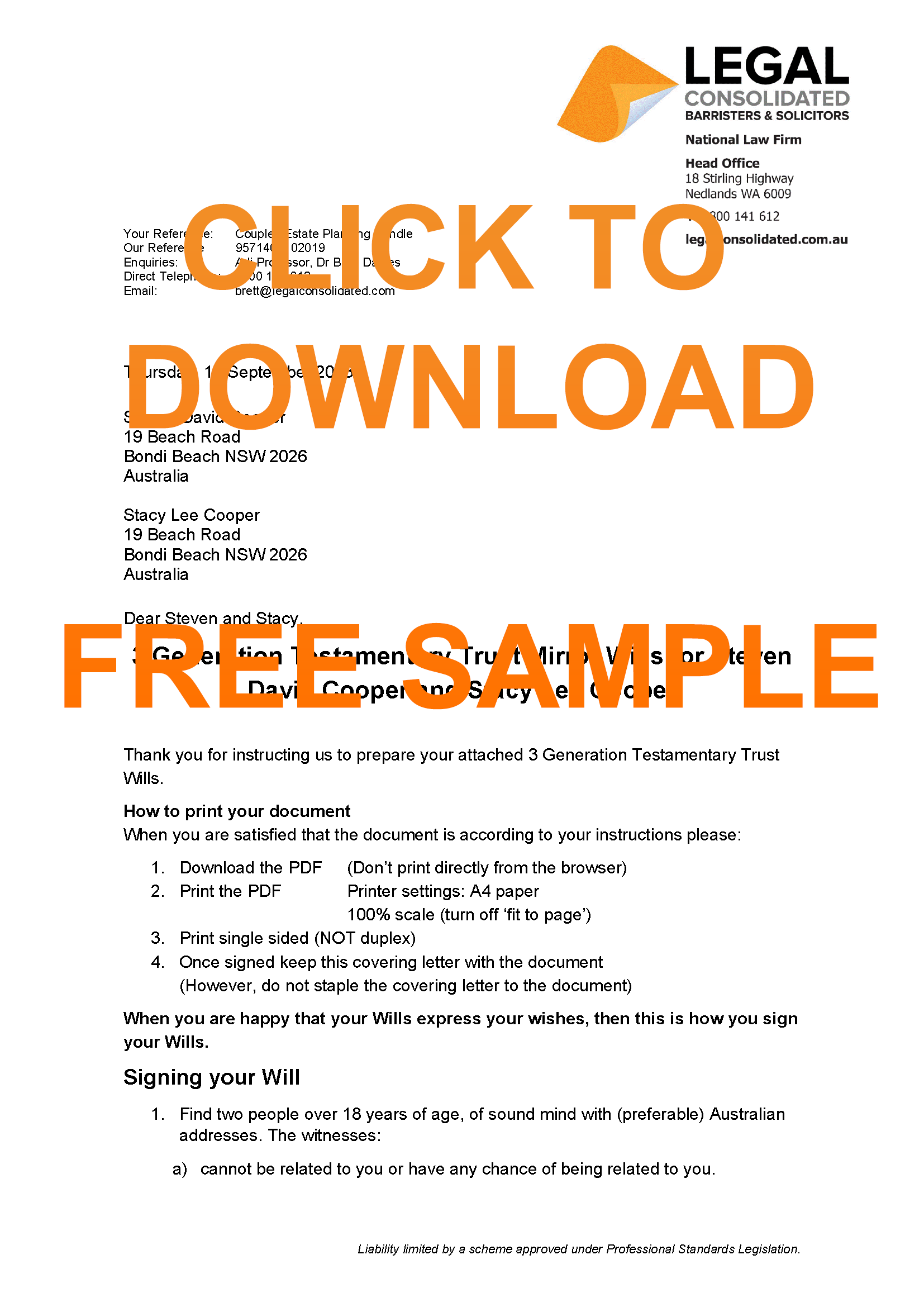Ten-point check before you decide who is to prepare your Unit Trust kit
Before building a Unit Trust, check that the provider meets these 10 legal and tax essentials. If the provider is not a law firm, email them this checklist and ask for written answers. Legal Consolidated’s Unit Trust Kit satisfies all 10.
☐ 1. The Law Firm Shield Your Unit Trust comes under the cover of a law firm’s letterhead, confirming that a law firm prepared your Unit Trust deed. As an Australian law firm, we give you legal professional privilege. This protects your communications with us—even in court. Non-law firms cannot offer this.
☐ 2. The ‘Forever’ Trust (Maximum Duration and Adapts to Law Changes) Most Unit Trust deeds cap the life of the trust at 80 years or 125 years in QLD. Legal Consolidated Unit Trusts last as long as the law allows—forever in South Australia. As the laws change, the life of the Unit Trust is automatically extended to the longer date.
☐ 3. Financial Firewall (Asset Protection) Your personal assets stay protected. Unitholders are only liable for the amount they paid for their units. If the trust fails, you do not lose your own money. See Broomhead v Broomhead.
☐ 4. Finance-Ready Solicitor’s Certificate Banks require a law firm’s letter confirming borrowing powers. Your kit includes a signed Solicitor’s Certificate valued at $1,250—no extra lawyer fees or delays needed when you apply for finance.
☐ 5. The Bamford Power (Advanced Tax Streaming) To reduce tax, the deed must follow Commissioner of Taxation v Bamford. This allows the Trustee to define “income” to match taxable income. It allows capital gains and franked dividends to be streamed to unitholders.
☐ 6. Reduce CGT Event E4 CGT Event E4 triggers a capital gain for unitholders who receive certain non-assessable payments, which reduces the cost base of their units. Deeds should contain a flexible definition of income, giving the Trustee the power to define what constitutes the trust’s income each year. This allows the Trustee to treat capital gains as distributable income—a key strategy to minimise unforeseen Event E4 liabilities.
☐ 6. The Unitholder ‘Prenup’ (Dispute & Deadlock Resolution) Disputes between unitholders ruin trusts. Our deed includes expert valuation, dispute resolution, and a ‘shotgun’ clause to break 50/50 deadlocks—without going to court.
☐ 7. Super-Majority Rules (Stable Governance) To ensure stability, fundamental decisions, such as appointing or removing a Trustee or amending the deed, require a Special Resolution (a 75% majority). This provides stability and protects minority unitholders by ensuring a significant consensus is required for any major changes.
☐ 8. Global & SMSF Compliance The deed is safe for all types of investors. It contains an overriding compliance clause to protect a Self-Managed Superannuation Fund (SMSF) from breaching the Superannuation Industry (Supervision) Act 1993. It also has clear powers for the Trustee to manage dealings with overseas investors under the Foreign Investment Review Board (FIRB) and tax laws.
☐ 9. Secretarial Pack Legal Consolidated provides more than just a Unit Trust deed; we deliver a comprehensive legal framework for the establishment and ongoing governance of your Unit Trust.:
-
Law Firm Letter of Advice providing guidance and confirming that your documents are prepared directly by a law firm.
-
Foundation Minutes and Resolutions The formal record of the trustee’s decision to establish the trust and issue the initial units, ensuring procedural correctness from the outset.
-
A Contemporary, Lawyer-Drafted Unit Trust Deed The cornerstone of the Unit Trust structure, our deed is meticulously drafted to be a robust, up-to-date instrument compliant with current Australian law. It provides a clear framework for management, distributions, and asset protection.
-
Statutory Register and Unit Certificates To meet your legal obligations, the pack includes the required Unit Holder Register for maintaining official ownership records, alongside professional Unit Certificates.
-
Ongoing Administrative Documents To facilitate the future management of the trust, the pack includes Unit Transfers, New Unit Applications, and Minutes to issue New Units.
-
Solicitor’s Certificate for Banks when borrowing (valued at $1,250).
☐ 10. Virtual Meetings & Electronic Notices Allows online unitholder meetings and electronic notices.
As tax lawyers, the Unit Trust Deed kit contains these ten best-practice standards.
What is a Unit Trust deed?
A Unit Trust deed sets out the Unit Trust rules. It is the Unit Trust’s rule book. Commonly, a Unit Trust either:
- holds assets; or
- runs a business.
For asset protection, a Unit Trust would not mix assets (low risk) with a business (high risk).
A Unit Trust apportions trust assets according to ‘units’. As a Unit Holder, you get beneficial ownership of trust property according to the number of units you own.
For example, you have 150 units and I have 50 units. Therefore, you own 75% of the Unit Trust assets. I own 25% of the assets in the Unit Trust. So, if the Unit Trust’s income is $100,000. You get $75k. I get $25k. There is no discretion.
A Legal Consolidated Unit Trust is the best of a Family Discretionary Trust and a company. In a Family Discretionary Trust, the Trustee holds the assets for the Beneficiary. So too, the Unit Trusts’ Trustee holds the assets for the benefit of the Unit Holders.
 Company vs Unit Trust
Company vs Unit Trust
Australian Unit Trusts are similar to companies.
- Unit Trusts have Unit Holders.
- Companies have shareholders.
- Unit Holders hold units in Unit Trusts
- Shareholders hold shares in companies.
Units may change in value. This is just like shares. The High Court of Australia demonstrates the benefits of Unit Trusts over companies. See Charles v Federal Commissioner of Taxation (1954) 90 CLR 598. This is because:
- in a company, a shareholder has no interest in company assets.
- in contrast, a Unit Holder has a proprietary interest in the Unit Trust assets.
This is in exact proportion to the Units that you hold in the Unit Trus.
Is it better to purchase a commercial property in a company or a unit trust?
With a Unit Trust, you potentially get a 50% CGT relief. Additionally, you may be eligible for small business CGT relief. A Unit Trust does not usually pay the CGT on the sale of an asset. Distributions from the Unit Trust form part of the unitholders’ income. This is subject to the unitholder’s own marginal tax rate. Franking credits, from company dividends such as BHP, are available for unitholders in a fixed unit trust.
A Unit Trust reduces CGT. A company is less likely to get the CGT discounts and relief.
In contrast, wealth is trapped in a company. It is challenging to extract wealth from a company. Also, unless you sell the shares in the company (which buyers generally do not want) the company does not get the 50% CGT relief. It is also difficult to get the small business CGT relief.
For this reason, accountants often consider a trust, such as a unit trust, to be the better vehicle for purchasing a property and other appreciating assets.
But CGT on the sale of the commercial property is only one issue. What about the income earned on the commercial property each year?
However, the eventual sale of the appreciating asset is only one issue. During that time, the commercial property earns income.
A downside of a Unit Trust is that you usually end up distributing (transferring) the annual profit out of the Unit Trust every year. This is because the unitholder pays the tax on their own tax return. In contrast, a company can ‘hoard’ or ‘retain’ the profit at the company’s fixed and constant tax rate.
For example, a Unit Trust and a company both have an income of $100k:
- The Unit Holders pay tax on that income at their marginal tax rate. For a human, this is up to 47%. If you pay the tax, you generally want your money.
- However, the company itself pays tax on the income. This is up to 30%. It then retains the income in the company.
 Negative gearing is quarantined for both the unit trust and the company
Negative gearing is quarantined for both the unit trust and the company
Negative gearing flows through to a sole proprietor, partners in a partnership and a Bare Trust. That reduces your tax. It is wonderful.
But companies and trusts (including a Unit Trust) cannot pass on the ‘loss’ to the shareholder or Unitholder. The loss is trapped in those vehicles. You can only ‘use up’ those losses by putting income-producing assets in the company or Unit Trust. “Negative gearing” is not possible unless the trust has other income to offset the losses.
A negative gearing loss on the property, for both the company and the Unit Trust, is trapped in both vehicles. You need other income to offset the loss.
You may be able to carry the tax loss forward to future financial years. If you cannot carry forward the losses to subsequent financial years, then the ‘loss’ is (pardon the pun) lost forever.
Tax Advantages of a Legal Consolidated Australian Unit Trust
In the company, there is a fixed tax rate. It is a constant tax rate. In contrast, the Unit Trust’s Unit Holders pay tax on the profit at their personal tax rate, which may be zero. In other words, the company pays tax on income. In a Unit Trust, the Unit Holders themselves generally pay the tax.
How a Company pays tax:
Each financial year, the company pays tax on its profit. The tax paid attracts an ‘imputation credit’. The company may retain this profit. The company does not have to pay the profit to the shareholders. The company does not have to declare a dividend.
At some point in the future, it can pay that profit to the shareholder. This is called a dividend. Only at that time does the shareholder have to pay tax on the dividend. The payment of a dividend is income in the hands of the shareholder. However, the shareholder can use the imputation credit to reduce the tax it would otherwise have to pay. For example, let’s say the company has already paid tax on the income at a tax rate of 25%. It then distributes that income to the shareholders. If the shareholder’s marginal tax rate is 45% then the shareholder only pays an additional 20% tax on the dividend.
How a Unit Trust pays tax:
In contrast, a Unit Trust distributes all its income to the Unit Holders. This is at the end of each financial year. The Unit Holders then pay tax at their personal marginal tax rate. (Any income not distributed is taxed automatically at the highest marginal tax rate. This is in the hands of the Unit Trust trustee.)
If the Unit Holder does not earn much income that financial year, then the tax on the Unit Trust income may be zero. But if the Unit Holder earns a lot of money that financial year, then its tax rate may be far higher than the fixed (constant) company tax rate. This is why you often hold the Units in a Family Trust: rather than in your own name.
The advantage of a company is that it can retain income at a constant tax rate and not distribute it to shareholders. The shareholder’s tax rate may be much higher than the company’s tax rate. This sounds good, except that it is challenging to use company funds for personal purposes. The company’s assets and profits are ‘trapped’ within the company. But you did temporarily save (or rather defer) the higher tax rate.
In contrast, each financial year, the Unit Holder pays tax on the income it derives from the Unit Trust. (The Unit Trust is therefore not taxed directly.) Our Unit Trust deed allows you to reinvest the income back into the Unit Trust. However, the Unit Holder must still pay tax on the income first. What the Unit Holder then does with the money is at their discretion. If the Unit Holder wishes to reinvest the after-tax dollars in the Unit Trust, they may do so.
Family Discretionary Trust vs Unit Trust
Unit Trusts and family trusts serve different purposes:
- Unit Trusts have ‘negotiability’: you can sell and buy units, and fixed annual entitlements to income and capital gains. The unit holders receive 100% of their entitlement. The trustee has no discretion to vary your entitlement.
- In contrast, Family Trusts are discretionary. This means that there are no fixed entitlements for any particular beneficiary. Mum and Dad (as the Appointors) direct the Trustee of the Family Trust to distribute income. This is generally aimed at the lowest-income earners in the family to reduce the family’s overall tax burden.
Unit Trusts are not a substitute for Family Trusts. Both types of trusts are often used together. For example, a Family Trust often holds units in a Unit Trust.
Family Trusts work for one family. Unit Trusts are appropriate for two or more families, joint ventures, businesses or partnerships in the management of assets. Instead, if you control assets in a single family, consider building one of our comprehensive Family Trust Deeds.
Unit Trust vs a partnership of family trusts
A company and a family trust are usually inferior to a Unit Trust. The greatest competition to a Unit Trust is a Partnership of Family Trusts. See here.
Do Unit Holders and Trustees go down with an insolvent Unit Trust?
The Unit Trust trustee is liable for the Unit Trust liabilities. The trustee has the right to indemnity. This is against the Unit Trust’s assets. If there is a shortfall, the Unit Holders may also be personally liable.
We review Unit Trusts going insolvent. Often, the Unit Holders are liable for the shortfall in assets. This is when the Unit Trust goes broke.
Unit Holders in a Unit Trust are liable to indemnify the trustees of a Unit Trust. This is for liabilities incurred by the business of the Unit Trust. See Justice McGarvie in Broomhead Pty Ltd (in Liquidation) v Broomhead Pty Ltd (1985) VR 891.
However, this rule does not apply if the right to indemnity is expressly revoked from the Unit Trust deed. Our Unit Trust deed protects unitholders from liability incurred by trustees. Our Unit Trust deed benefits the unitholders.
Common faults of Unit Trust deeds
Be careful of who drafts your Unit Trust deed. Many websites give the impression that a law firm prepares the documents, but in reality, the website merely sells a template, which is not protected. Common faults:
- The majority of the Unit Holders control 100% of the Trust assets
- The Unit Trust not complying with the Australian Tax Office lending guideline
- The Unitholders are personally liable for the Trust’s debts. This is under Broomhead Pty Ltd (in Liquidation) v Broomhead Pty Ltd (1985) VR 891
- An implied relationship between unitholders – they, therefore, become jointly and severally liable for each other’s debts
- The trustee pays tax on the trust income at the highest marginal tax rate. This is under section 99 Income Tax Assessment Act 1936 (Cth)
Can the value of the units change over time?
Yes, the value of the Units can change over time. Today you issue Units for $1.00 each. If your business performs well or the value of the assets increases, then a unitholder may sell their Units for, say, $5.00 each. Alternatively, the trustee of the Unit Trust may issue new Units at a higher price to individuals wishing to invest in the Unit Trust. That is a decision for the unitholders.
Can I update the Unit Trust deed?
While Family Trust deeds and Self-Managed Superannuation fund deeds are updated on average every 5-8 years, Unit Trust Deeds do not usually require updating to address tax and trust matters. However, you can update a Unit Trust as often as you wish, provided all unitholders agree.
Want to formalise the relationship between the unitholders? Build a Unitholders Agreement.
Unitholders may debate what the Unit Trust will do and invest in. But this is not a matter of the Unit Trust deed or the Unitholders Agreement. This is similar to a company’s shareholders’ agreement. When shareholders debate on how to run the business, they do not usually update the company Constitution or the Shareholders Agreement.
Unit Trusts suffer a fixed life of only 80 or 125 years
Some state governments do not want trust assets tied up forever. They aim to prevent assets from falling into disrepair. A trust usually cannot last more than 80 years (or 125 years in Queensland). This is called the Rule Against Perpetuities.
South Australia has not adopted the Rule Against Perpetuities. South Australian trusts can exist indefinitely.
This Rule comes from English law. In 1682, the 22nd Earl of Arundel sought to control the succession of his titles for thousands of years. The UK Courts refused to grant an indefinite Trust. The Court limited the life of the Trust.
Will other states also abolish the Rule Against Perpetuities?
We think so. Consider, for example, the two Westfield Unit Trusts:
- Westfield Trust; and
- Westfield American Trust.
They are both Unit Trusts. The Unit Trusts are governed by New South Wales law.
Collectively, they are worth AUS$58 billion. Because New South Wales governs the Trusts, they are subject to the Rule Against Perpetuities. Both Unit Trusts suffer the 80-year rule. The Westfield Unit Trust started in 1982. The Westfield American Unit Trust started in 1996. Both terminate on their respective 80th anniversary.
Unit Trust 80-year vesting period may be abolished – one day
Legal Consolidated continues to lobby the States and Territories to remove the rule of perpetuity. No doubt the lawyers at Westfields, and similar, are doing the same thing. There is a strong movement to abolish these rules. On 1 August 2025, Queensland led the way by increasing the time limit from 80 years to 125 years.
If the rule is abolished, then Legal Consolidated’s Unit Trusts, Family Trusts, Family Trust updates, and Bare Trusts are already drafted to extend the vesting period to infinity. This is automatic if the law is abolished.
Is it bad to have a trust come to an end?
On vesting, two taxes apply:
- Capital Gains Tax (CGT) (Federal Tax)
- Transfer (Stamp) Duty (State Tax)
All Australian Unit Trusts suffer CGT and (stamp) transfer duty. Therefore, Unit Trusts attempt to defer this liability by extending the Trust’s existence. Legal Consolidated trust deeds adopt this approach.
There are also family law and bankruptcy issues.
Using a Unit Trust as a Property Trust
A Legal Consolidated unit trust is an excellent vehicle for establishing a property trust, particularly due to its flexibility and structure, which is tailored for group investments in real estate.
Structure and Functionality of a Property Trust
In a Legal Consolidated unit trust, the trust itself owns the property, and investors buy units in the trust. Each unit represents a share of the trust’s property assets. This structure enables multiple investors to collectively own and benefit from real estate, which may be less accessible to them individually due to high capital requirements.
Tax Efficiency of a Property Trust
Unit trusts are known for their tax-efficient distribution of income. Income generated from the property, such as rental income, is passed directly to unit holders, usually in proportion to the number of units they hold. For the investors, these distributions are treated as personal income, allowing them to take advantage of any tax benefits associated with their personal tax situations, such as offsetting losses against other income.
Example of a Property Trust (Commercial Property Syndicate)
A Legal Consolidated unit trust is a widely used structure for business or investment purposes, where each beneficiary holds a predetermined share of the trust’s assets. Beneficiaries of a commercial property unit trust are allocated a portion of both income and capital appreciation proportional to their ownership stake in the trust’s assets.
For example, consider a property investment that issues 1,000 units of a property unit trust, encompassing $10,000,000 worth of commercial real estate. If you acquire 10 units of this trust, you effectively hold a 1% ownership interest. This entitles you to a corresponding 1% of the income generated and the capital growth from the properties.
In scenarios involving a unit trust, also referred to as a commercial property syndicate, numerous investors pool their capital to invest in one or more properties held within the unit trust.
Six advantages of using a Unit Trust as a Property Trust (Syndicate)
A unit trust structure provides several advantages for investors in commercial real estate, including:
-
- Pooling of Funds: It allows investors to collectively pool their funds to purchase commercial real estate that would be otherwise too expensive for an individual to acquire alone.
- Income Distribution: It distributes pre-tax income to beneficiaries, where the income is then taxed according to the beneficiary’s personal income tax rate.
- Tax Minimisation: It helps in avoiding significant tax implications typically associated with direct property ownership.
- Cost Sharing: It facilitates the splitting of large expenses involved in commercial property ownership among all investors.
- Regulatory Advantages: It is subject to a lower level of financial regulation, which can be beneficial. For example, some investors use a Self-Managed Super Fund to invest in commercial real estate trusts.
- Professional Management: Investors benefit from having a professional property management team that manages the investment from due diligence and acquisition to divestment.
Common faults of non-law firm Unit Trust deeds
Be careful who drafts your Unit Trust deed. Many websites give the impression that a law firm prepares its documents, but in reality, the website merely sells a template. A document from a non-law firm is not protected by legal professional privilege. Common faults in these basic templates include:
1. Fault: A 51% majority controls everything.
-
Risk: In a poorly drafted deed, a unitholder with a bare majority (51%) can completely control the trust. They can appoint their spouse as the trustee, sell all the assets, and change the deed against the wishes of the 49% minority. The minority unitholders are left powerless.
-
The Legal Consolidated Solution: Our deed prevents this. It requires a Special Resolution (a 75% majority) for all fundamental decisions. This provides stability and protects minority unitholders from being unfairly dominated.
2. Fault: Unitholders are personally liable for the Trust’s debts.
-
Risk: Unless the deed expressly and correctly limits a unitholder’s liability, a court may rule that the unitholders must personally indemnify the trustee for the trust’s debts. This was the disastrous outcome in the case of Broomhead v Broomhead. This means if the trust fails, creditors can pursue the unitholders’ family homes and other personal assets.
-
The Legal Consolidated Solution: Our deed contains a specific Liability Shield clause, drafted in line with the principles of Broomhead, which is designed to limit unitholder liability to any unpaid amount on their units and protect their personal assets.
3. Fault: The Trust is taxed at the highest rate.
-
Risk: This is a common and expensive trap in old deeds. If a trust has taxable “net income” but no corresponding “trust law income” to distribute (due to an inflexible definition), the Trustee is assessed on that income at the highest marginal tax rate. This is required under section 99A of the Income Tax Assessment Act 1936.
-
The Legal Consolidated Solution: Our deed’s modern Net Income definition, drafted in line with the High Court’s Bamford decision, gives the Trustee the crucial flexibility to align the trust’s income with its taxable income. This ensures all income can be distributed to the unitholders to be taxed at their own, lower marginal rates.
4. Fault: An implied partnership is created.
-
Risk: If the deed is not carefully drafted, a court may decide that the relationship between the unitholders is actually a partnership. This would make all unitholders jointly and severally liable for 100% of the partnership’s debts, completely defeating the purpose of the trust.
-
The Legal Consolidated Solution: Our deed contains an express clause stating that nothing in the deed is to be construed as creating a partnership between the unitholders.
5. Fault: The deed does not comply with ATO lending guidelines.
-
Risk: The ATO has strict rules (like Division 7A) that govern loans between companies and related trusts. A deed that lacks the necessary powers for a trustee to enter into a compliant loan agreement can inadvertently trigger a “deemed dividend,” resulting in a massive and unexpected tax bill. We have seen a Unit Trust sign a Div 7A Deed, but the deed does not operate because the Unit Trust deed does not allow it.
-
The Legal Consolidated Solution: Our deed contains broad borrowing and trustee powers, providing the necessary authority for the Trustee to work with their accountant to structure any loans in full compliance with all ATO requirements.
Who pays tax on Unit Trust income – the trust or the unit holder?
The High Court in Charles v FCT [1954] HCA 16; 90 CLR 598 confirmed that the interposition of a unit trust does not, for tax purposes, change the character or source of income in the hands of the beneficiary.
This is the high-water mark of what I have long called the “trust conduit theory”—the idea that income retains its character (e.g. interest or dividend) as it passes through the trust to the beneficiary. The Court said (at 609):
“…the question whether moneys distributed to unit holders… form part of their income or their capital must be answered by considering the character of those moneys in the hands of the trustees before the distribution is made.”
But even here, the Court was cautious. It did not state that the beneficiary receives the trustee’s income, only that the character is determined by what it was in the trustee’s hands—capital remains capital, and revenue remains revenue.
However, the theory does not apply in full unless the trust is a bare trust or the beneficiary has an interest in possession in the income as it arises. See FCT v Tadcaster Pty Ltd (1982) 13 ATR 245.
In Executor Trustee & Agency Co of SA Ltd v DCT (SA) [1939] HCA 35; 62 CLR 545, the High Court rejected the theory where the trustee exercised discretion. Latham CJ (at 558):
“In view of the fact that a discretion exists… it seems to me to be impossible to hold that the [beneficiaries] are entitled specifically to the rents and profits.”
So, even in unit trusts, while the character of income may flow through, the source and taxable nature depend on facts: the trustee’s activity, whether income is passive or business-derived, and the terms of the deed. See also Nathan v FCT.
Should a Unit Trust for property development also have a Unitholders Agreement?
The Unit Trust Deed is the correct legal vehicle for holding the property and securing finance from a bank. You also need a Unit Holders Agreement containing project-specific rules for profit distribution ‘waterfalls’, staged capital contributions, day-to-day management, and dispute resolution. The Unit Trust Deed provides the foundation; the Unitholders’ Agreement builds the commercial house on top of it.
See also:
Stamp duty when you transfer business real property from a Unit Trust to a Self-Managed Super Fund
Tax-effective business structures
Extending a Unit Trust’s vesting date
How to wind up and vest a Unit Trust
Other Business Structures in Australia
Family trust
- Family Trust Deed – watch the free training course
- Family Trust Updates:
- Everything – Appointor, Trustee & Deed Update
- Deed ONLY – only update the Deed for tax
- Guardian and Appointor – only update the Guardian & Appointor
- Change the Trustee – change human Trustees and Company Trustees
- The company as Trustee of Family Trust – only for assets protection?
- Bucket Company for Family Trust – tax advantages of a corporate beneficiary
Unit trust
- Unit Trust
- Unit Trust Vesting Deed – wind up your Unit Trust
- Change Unit Trust Trustee – replace the trustee of your Unit Trust
- Company as Trustee of Unit Trust – how to build a company designed to be a trustee of a Unit Trust
Corporate structures
- Partnership Agreement – but what about joint liability?
- Incorporate an Australian Company – best practice with the Constitution
- Upgrade the old Company Constitution – this is why
- Replace lost Company Constitution – about to get an ATO Audit?
- Independent Contractor Agreement – make sure the person is NOT an employee
- Service Trust Agreement – operate a second business to move income and wealth
- Law firm Service Trust Agreement – how a law firm runs the backend of its practice
- Medical Doctor Service Trust Agreement – complies with all State rules, including New South Wales
- Dentist Service Trust Agreement – how dentists move income to their family
- Engineering Service Trust Agreement – commonly, engineers set up the wrong structure
- Accountants Service Trust Agreement – complies with ATO’s new view on the Phillips case

